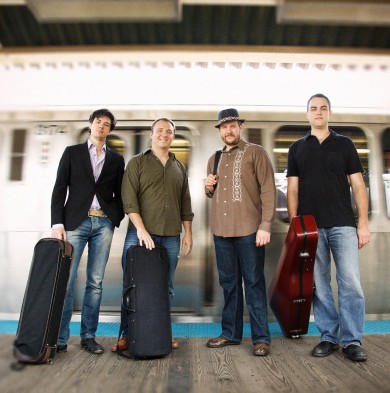Seraphic’s mixed “Seven Last Words” proves more operatic than reflective
Seraphic Fire’s latest project is a collaboration with Chicago’s Spektral Quartet in Franz Joseph Haydn’s The Seven Last Words of Christ. Artistic director Patrick Dupré Quigley’s hour-long program continues to fulfill Seraphic’s mission to present deserving, under-performed works.
Haydn originally wrote the Seven Last Words as quiet orchestral meditations for a Good Friday service, but he created three additional versions: a string quartet, a choral-orchestral oratorio, and a piano solo.
In the Baroque and Classical periods, oratorios were essentially unstaged, biblical operas, satisfying the public taste for the sensational operas prohibited during Lent. Quigley’s interpretation is decidedly grand and operatic for this combined version of Haydn’s string quartet and choral arrangements, created exclusively for Seraphic and Spektral.
From the opening Introduzione I for strings, Spektral’s ten-year experience of performing the quartet version showed. With perfectly coordinated entrances and silences, Spektral’s mature, passionate rendition had the purity and precision of a Mozart overture. This sober, forceful tone prevailed in the chorus for the remaining seven Sonatas.
In the resonant space of Miami’s St. Sophia Greek Orthodox Cathedral, the atmosphere was big and theatrical rather than reflective and spiritual. While the music could be more thoughtful and intimate, hearing Spektral’s precise detailing made a worthy tradeoff.
Noting that the Seven Last Words are actually the seven last phrases that Christ spoke on the cross, Quigley introduced each Sonata’s corresponding phrase through unadorned, clearly delivered choral incipits or first few words of the text.
In the oratorio proper, Quigley’s dramatic approach often sounded thick in the live acoustic. Quigley chose bright, heavy voices, from his roster, which occasionally, bordered on shrill, for strength over subtlety. The cathedral favors high voices and exposed some flat soprano singing at first, although they quickly adjusted.
Unfortunately, the Seraphic singers too often buried the Spektral Quartet, which emerged only occasionally in instrumental passages. In Sonata No. 1, “Vater, vergib ihnen,” a duo between Spektral’s first violinist Aurelian Fort Pederzoli and soprano Estelí Gomez provided respite from the power, as did vocal quartets in No. 3, “Frau, hier siehe deinen Sohn” and No. 5, “Jesus rufet: Ach, mich dürstet!”
Lovely pizzicato and tasteful countermelodies added colorful sparks to Seraphic’s stirring Sonata No. 2, “Fürwahr, ich sag es dir.” Lower voices emerged with expressively Classical melodies in No. 3, “Frau, hier siehe deinen Sohn,” for a heavy and grand effect.
These also graced the rich, quieter opening of No. 4, “Mein Gott, mein Gott.” in which Quigley’s phrasing matched Spektral’s for the best moments of the evening. A gorgeous violin solo and subdued ending provided contrast to the previously assertive Sonatas.
In Introduzione II, Spektral’s experience was showcased by flawless ensemble unisons and pizzicato attacks. The printed program omitted the text of “Jesus rufet,” causing some confusion, but Brad Diamond’s tenor solo was a bright spot, one of the purer solo voices of the night.
The best balance came in the quiet unison opening of No. 6, “Es ist vollbracht!,” revealing Spektral’s gracefully shifting colors. Mela Dailey’s lighter soprano solos blended well with Pederzoli’s figuration, and Russell Rolen’s smooth basement cello stunned.
Spektral’s Romantic interpretation of the last Sonata also conveyed a sense of peace, and Quigley held Seraphic back for a tender performance. A final earthquake movement, based on the Good Friday story, featured chromatic rises and tremolo swells in strings, and Seraphic in unison chords, for a stormy finish.
Seraphic Fire began the concert with a bonus: the middle movement from Morton Lauridsen’s Lux Aeterna, “O Nata Lux”. Dedicated to the recently deceased Los Angeles Master Chorale director Paul Salamunovich, the enthusiastic, overly loud but heartfelt tribute might be forgiven in the emotion of the moment.
Haydn’s Seven Last Words will be repeated 7:30 p.m. Thursday at St. Gregory’s Episcopal Church, Boca Raton; 7:30 p.m. Friday at First United Methodist Church, Coral Gables; 8 p.m. Saturday at All Saints Episcopal Church, Fort Lauderdale; and 4 p.m. Sunday at All Souls Episcopal Church. 305-285-9060; seraphicfire.org.
The program will also be performed 7:30 p.m. April 16 in Chicago at Rockefeller Memorial Chapel in the University of Chicago Presents series (ticketsweb.uchicago.edu; 773-702-8068); and 7:30 p.m. April 18 at Lawrence Memorial Chapel, in Appleton, Wisconsin (lawrence.edu; 920-832-6749).
Posted in Performances
Leave a Comment
Thu Apr 10, 2014
at 12:49 pm
No Comments





